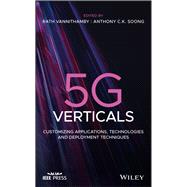A comprehensive text to an understanding the next generation mobile broadband and wireless Internet of Things (IoT) technologies
5G Verticals brings together in one comprehensive volume a group of visionaries and technical experts from academia and industry. The expert authors discuss the applications and technologies that comprise 5G verticals. The earlier network generations (2G to 4G) were designed as on-size-fits-all, general-purpose connectivity platforms with limited differentiation capabilities. 5G networks have the capability to demand customizable mobile networks and create an ecosystem for technical and business innovation involving vertical markets such as automotive, healthcare, manufacturing, energy, food and agriculture, city management, government, public transportation, media and more.
5G will serve a large portfolio of applications with various requirements ranging from high reliability to ultra-low latency going through high bandwidth and mobility. In this book, the authors explore applications and usages of various 5G verticals including a set of key metrics for these uses and their corresponding target requirements. The book also examines the potential network architectures and enabling technologies to meet the requirements of 5G verticals. This important book:
- Offers a comprehensive resource to the promise of 5G Verticals
- Provides a set of key metrics for the uses and target requirements
- Contains illustrative examples of the technology and applications
- Includes contributions from experts in the field and professionals that developed the 5G standards
- Provides an analysis of specific vertical industries which have the potential to be among the first industries to use 5G
Written for industry practitioners, engineers and researchers, 5G Verticals discusses the technology that enables the 5G system to be flexibly deployed and scaled.








